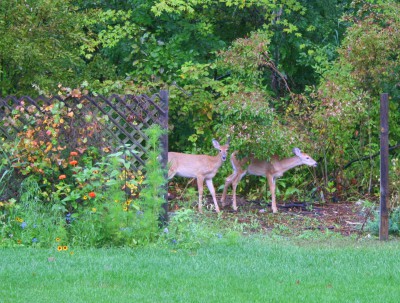Deterring Deer Damage by Fencing Them Out
By Carmine Carosella, Fairfax Master Gardener
So, you live near the Beltway in prime urban deer habitat. And you’re tired of all the damage those pesky creatures are doing. What’s a gardener to do? OK, you could grow deer-resistant plants, but you love your hostas! Well, what I did was try to understand the urban deer, consult with people who’ve found solutions, and apply those solutions to my garden.
 I live in Falls Church and face a small herd of about seven deer that roam the neighborhood. They come by periodically, perhaps once a week from spring to fall, less in the winter. Usually I see them at dawn or dusk, but they also forage during the night. With people and dogs about during the day, they lie low. The deer are certainly creatures of habit, taking the same feeding routes time after time. Our deer are well fed and lazy; they eat only the choicest stuff. I have a 1-acre lot with many azaleas, but the deer eat only the plants along established feeding paths and only at a convenient height. The hostas in pots are very vulnerable; the deer don’t even have to bend over to eat them. The same is true for flowers in pots, as well as certain tall-growing plants such as aucubas, wood begonias, and hydrangeas.
I live in Falls Church and face a small herd of about seven deer that roam the neighborhood. They come by periodically, perhaps once a week from spring to fall, less in the winter. Usually I see them at dawn or dusk, but they also forage during the night. With people and dogs about during the day, they lie low. The deer are certainly creatures of habit, taking the same feeding routes time after time. Our deer are well fed and lazy; they eat only the choicest stuff. I have a 1-acre lot with many azaleas, but the deer eat only the plants along established feeding paths and only at a convenient height. The hostas in pots are very vulnerable; the deer don’t even have to bend over to eat them. The same is true for flowers in pots, as well as certain tall-growing plants such as aucubas, wood begonias, and hydrangeas.
When it comes to stopping deer, who would know better than growers of hostas and roses — plants that are often called deer candy? The president of the American Hosta Society, Don Dean, shared his techniques with me. He recommended a systemic tablet called Plant Saver. It contains the bitter chemical denatonium benzoate, which is absorbed by the hosta and makes it unappetizing to deer for about one year. It works! Unfortunately, the product is prohibitively expensive for large plant collections. More practically, he mentioned the product Milorganite, which is sold as a natural fertilizer but has a very strong odor. Sprays that smell like rotten egg, such as Liquid Fence, work well but all seem to require repeated application. The least expensive treatment Dean recommended was a homemade mixture of hot sauce, egg, and liquid dish detergent.
I also consulted the president of the Arlington Rose Foundation, Pam Powers. She endorsed a nearly invisible deer fencing technique: fishing line strung between green garden stakes. Deer have poor vision. Although they can easily break through such a structure, they would rather not; it seems to spook them. Many rose growers in Arlington County are protecting their beds this way. Powers also suggested a spray product called EverGuard Deer Repellent that, once again, has the rotten egg smell. She said it’s best to spray not only the roses but also any objects along the deer’s approach path to the roses.
Here are my own observations. I’ve gone the rotten egg spray route (Bobbex) and have tried Milorganite. For example, I use Milorganite in my potted plants, mostly as a fertilizer but also as a deer deterrent. This works for a while, but the deer still wander around the yard looking for things to eat. It was time I tried the fishing line fence.
 The first step was to block the easy passageways the deer take between my yard and the surroundings. Pictured above is a pathway frequented by deer and my neighbor. The 7-foot poles are driven into the ground and connected together with clear 50-pound fishing line. This is actually a gate, with one of the poles supported inside a plastic pipe sunk in the ground; the pole is held in place with a bungee cord. My neighbor can still visit.
The first step was to block the easy passageways the deer take between my yard and the surroundings. Pictured above is a pathway frequented by deer and my neighbor. The 7-foot poles are driven into the ground and connected together with clear 50-pound fishing line. This is actually a gate, with one of the poles supported inside a plastic pipe sunk in the ground; the pole is held in place with a bungee cord. My neighbor can still visit.
I also constructed a 150-foot deer fence with poles placed about 8 feet apart along one property boundary. The deer were grazing there for acorns. For a week or so I found the fishing line broken in places, which I immediately fixed. After a while, however, the fence was left alone. A night vision camera showed the deer outside my property eating acorns but staying away from the fence.
The fishing line fence worked. There are still many places the deer can enter the yard, such as up a driveway, but so far they have not. The fishing line fence is relatively cheap to build, unobtrusive, and easily removed. It would be an ideal way to protect flower beds and foundation plantings, for example.
Reference
Effective Deer Fences, University of Vermont, Department of Plant and Soil Science
… updated 2021